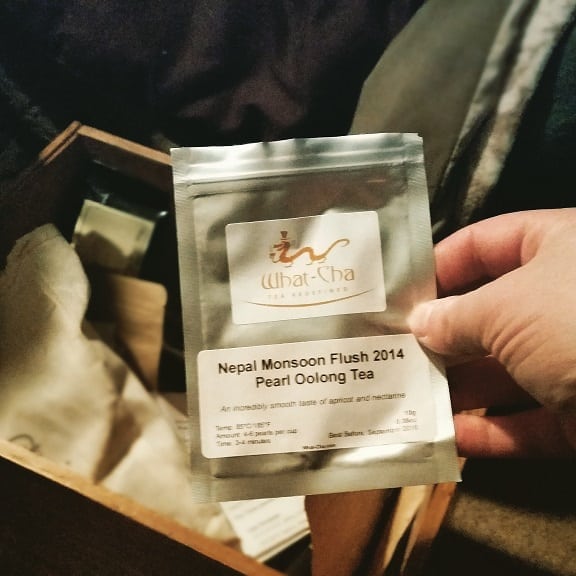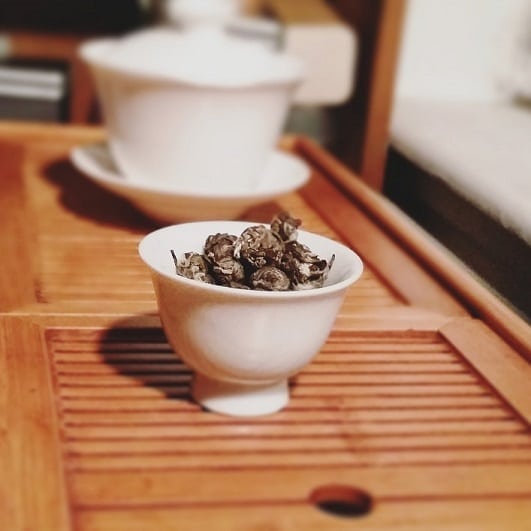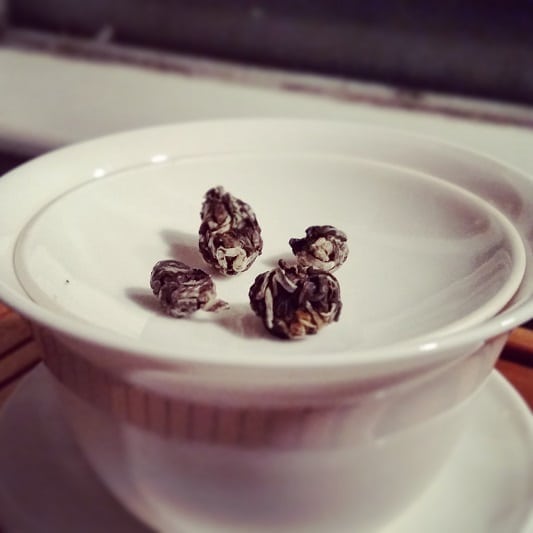NaNoTeaMo, Day 8: “Monsoon Flush Oolong in a Deluge”
It rained today. A lot.
Okay, that’s not an unusual statement to make in the Portland area during late-Fall. But the sheer amount of rain we’ve received in the last month seems like overkill. Today, at work, I had to take out the garbage . . . in the middle of a deluge spell. All I had on hand for protection against the elements was a trash bag DIY-ed into a makeshift raincoat/burka thingy.
It didn’t work.

At the end of that work shift, and after braving the torrential downpour at least three more times, I had a sudden urge to brew something with the word “rain” in it. However, in my vast stores, I didn’t think I possessed anything even close to that. Not even rainforest. Perhaps “monsoon”?
Maybe I had a monsoon flush something-er-other lying around somewhere. For you tea-newbies out there, a “monsoon flush” is not an overflowing toilet. (Although, I did deal with a couple of those at work.) Rather, a monsoon flush refers to a tea leaf picking period of time between the first and second flush harvests. First flush usually goes from late-February to sometime in May. Second flush is from late-May to July(ish). And everyone’s favorite redheaded stepchild, the autumnal flush, starts around late-August. The monsoon flush – while not a formal harvest time – occurs during the stormy period between the second and autumnal flushes.
At least, that’s how it’s done in India, Darjeeling in particular. It wasn’t beyond the realm of feasibility that Nepal would do something similar. In my trusty ol’ backlog box, I found just such a tea – a sample of Pearl Oolong from What-Cha Tea, Monsoon Flush, 2014.

Wow . . . I totally forgot to get to this one. By a half a year at least. For the sake of full-disclosure, What-Cha does, indeed, have this tea in their roster. The one currently available is the August 2015 Monsoon Flush tea. I’m covering one released a whole year ago. While I assume the style is still the same, a lot of changes in terroir and method could’ve occurred between then and now . So, take the succeeding taster notes with a grain of salt.
While I was expecting pearls, as the name described, I was not prepared for how big they were. Holy heck, these were rolled like jasmine pearls. Only without that whole offending jasmine smell. Total win.

The li’l balls were about the size of a fingernail, and gave off an aroma of pure delight; something both muscatel and rebelliously citrusy. As if to say, “Yeah, we’re near Darjeeling . . . but we ain’t. ‘What-Cha’ gonna do about it?!”

I’m not taking that pun back.
Brewing instructions on the bag said to heat water to roughly 185F, and to use between 4-6 pearls per cup.

Not in the mood to risk an overly monsoon-y taste, I used four, and steeped said pearls in a gaiwan for three minutes.
The liquor brewed to a pale amber bit o’ excellence with a vaguely orange-ish/grapy aroma. Already, things were lookin’ good. I dared a sip.

It wasn’t as strong a flavor profile as I was expecting based upon the dry scent, but it was still quite pleasant. There was a subtle sweetness throughout the sip that complimented the natural citrus overtones rather perfectly. The taste was very Himalayan, in all the good ways.
A satisfying cup o’ monsoon on a deluge of a day.
Leave a Reply